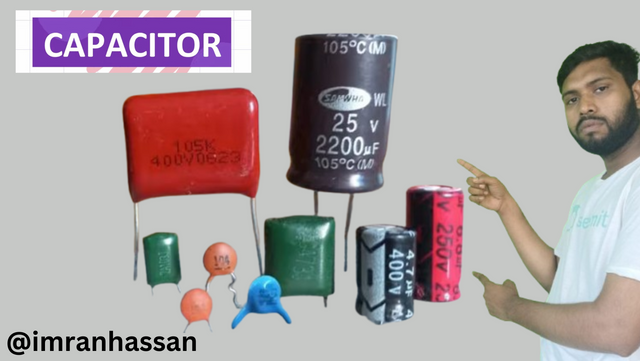Electrical Learning || Part 05 || What is a capacitor, how it works, and why it is used?
Assalamualaikum Everyone. I am @imranhassan
From #Bangladesh
How are you all, hope you are well In today's post, we will know very easily through animation what a capacitor works, why it is used, where it is used, and how many types of capacitors are used. Capacitor, which means container in Bengali as the name suggests, holds something.
Basically, these names are based on the material they are made of, but based on polarity, capacitors can be divided into two parts. One is polarized capacitor and the other is non-polarized capacitor, to say polarized capacitor, which has positive and negative. To use polarized capacitor in the circuit, it is necessary to connect the positive of the capacitor with the positive of the supply and the negative of the capacitor with the supply negative, i.e. connect it in forward bias. And if we connect reverse bias, then the capacitance will be lost.
The symbols we see below the polarized capacitor are plus and minus symbols. And polarized capacitor capacitor has a black part around it and a white part on one side. The white part is the minus terminal and the surrounding black part is the plus terminal. A polarized capacitor must be connected to a DC supply. Otherwise, the capacitor will be blasted if connected to AC circuit
The capacitors that we can see on the screen now are non-polarized capacitors; non-polarized capacitors do not have any negative or positive. They can be connected to the circuit in any way. Non-polarized capacitor capacitors can be used in both AC and DC, but polarized capacitors are used in DC. At the bottom we see the non-polarized capacitor symbol where there is no positive or negative. There are usually two types of values given on the capacitor, one is the voltage value and the other is the capacitance value. The voltage rating refers to the maximum number of volts it can operate at. And the value of capacitors refers to the capacity of this capacitor, i.e., how much charge it can hold per volt.
As batteries have voltage and mh, capacitors have voltages and capacitors have values. The unit of a capacitor is farad, which means a very large value, so capacitor values are written as milli farad, micro farad, nano farad, pico farad. The value of a polarized capacitor is written in milli farad and micro farad. The values of non-polarized capacitors are written in nano farad and pico farad.
Well, we come to the real picture many times we see that even after some devices are switched off some devices still have current for a while.
Then slowly the power ends, as seen on the screen, but this work is done by a capacitor.
To understand the matter a little better we can look at this circuit. Here, as soon as the switch is turned on, the LED also turns on. But after giving the switch, the capacitor will start charging and the LED will light up. Again, when the voltage of the capacitor and the battery become equal, the capacitor will not charge.
Now if we completely disconnect the line from the battery, then the light will be on by taking the line from the capacitor, and once the capacitor is fully discharged, the LED will be completely off.
Let's say one thing here: as much as the voltage of the supply is, the voltage of the capacitor should be 1.5 times or 2 times more. If we use the capacitor with less voltage than the supply voltage, then our capacitor will be blasted and destroyed.
To better understand the capacitor, we can compare it to a water tank. Think that this water tank is a capacitor, and the water line above is the input. And the line going down is the output. That is, this line will go to the LED or the supply. Now we can see that the charge coming from the battery is going directly to the output, and the capacitor is also getting charged at the same time.
Now if we turn off the battery line but the input turns off but the output turns off. Because the capacitor is now discharging as much charge as it was holding. The higher the capacitance of the capacitor, the longer the capacitor can hold the charge, and if it can hold the charge for a longer time, it can provide a longer backup.
Since the capacitor is a basic component of electronics, it cannot be overstated. But one of its important functions is to filter the circuit board and convert the AC current into DC. When making DC, the ripple AC current that occurs at the output of the rectifier is converted to pure DC through a capacitor. High-pass filters, low-pass filters, etc. are used for many other purposes. Can be used to make power supplies.
Let's say one thing, but never touch the two terminals without completely discharging the high-voltage capacitor. But then you will eat a complete shock; if it is a 400-volt capacitor, then you will eat a shock of a 400-volt capacitor. Many times a big accident can also happen; definitely discharge the capacitor with the help of an electric device. In today's post, I have tried to clarify the concept of capacitor. However, in this short post, I may have made some mistakes about electronics, so if you have any questions, please let me know in the comments.

.png)
.png)
.png)
.png)
.png)
.png)
.png)
.png)
.png)
.png)
.png)
.png)
.png)

.gif)
Upvoted. Thank You for sending some of your rewards to @null. It will make Steem stronger.
X Promotion